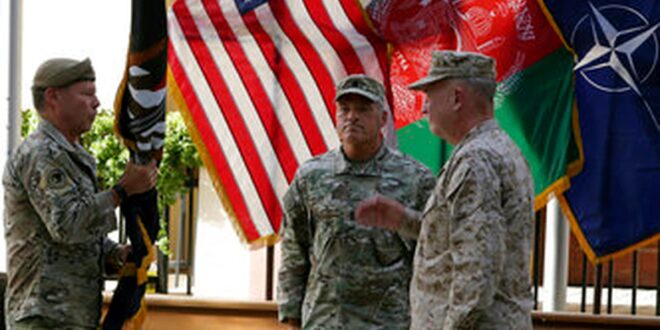The top U.S. commander in Afghanistan handed over his command at a ceremony in the capital of Kabul on Monday, as America winds down its 20-year military presence and Taliban insurgents continue to gain territory across the country.
Gen. Scott Miller transfered authority to Marine Gen. Frank McKenzie, the head of U.S. Central Command.
McKenzie, also a four-star general, will operate from Central Command headquarters in Tampa, Florida. He will assume authority to conduct possible airstrikes in defense of Afghan government forces, at least until the U.S. withdrawal concludes by Aug. 31.
In a flag-passing ceremony, Miller remembered the U.S. and NATO troops killed in the nearly 20-year war as well as the thousands of Afghans who lost their lives. More than 2,400 troops died and more than 20,000 were wounded in support of operations in Afghanistan, according to DoD figures. The war cost taxpayers more than $2 trillion, according to the Cost of War Project. The project also estimated that 71,344 civilians; 78,314 Afghan military and police; and 84,191 opposition fighters died during the conflict. These figures do not include deaths caused by disease, loss of access to food, water, infrastructure, and/or other indirect consequences of the war.
Miller warned that relentless violence across Afghanistan is making a political settlement increasingly difficult. The outgoing commander said he has told Taliban officials “it’s important that the military sides set the conditions for a peaceful and political settlement in Afghanistan. … But we know that with that violence, it would be very difficult to achieve a political settlement.”
Afghanistan’s National Security Adviser Hamdullah Mohib, who attended the handover, said the U.S. and NATO withdrawal has left a vacuum that resulted in Afghanistan’s national security forces stranded on the battlefield without resupplies, sometimes running out of food and ammunition.
In comments after the ceremony, Mohib said the greatest impact of the withdrawal is a lack of aircraft to resupply troops. Currently, the government is regrouping to retake strategic areas and defend its cities against Taliban advances.
The handover ceremony took place in the heavily fortified Resolute Support headquarters in the heart of Kabul, at a time of rapid territorial gains by Taliban insurgents across Afghanistan.
The Afghanistan National Defense and Security Forces, mostly funded by the United States and NATO, have put up resistance in some parts of the country, but overwhelmingly Afghan government troops appear to have abandoned the fight.
In recent weeks, the Taliban have gained several strategic districts, particularly along the borders with Iran, Uzbekistan and Tajikistan.
The Taliban control more than one-third of Afghanistan’s 421 districts and district centers. A Taliban claim that they control 85 percent of the districts is widely seen as exaggerated.
After Miller’s departure, a two-star admiral based at the U.S. Embassy in Kabul will oversee the U.S. military’s role in securing the American diplomatic presence in Kabul, including defending the Kabul airport.
Miller’s departure does not reduce the scope of the U.S. military mission in Afghanistan, since McKenzie will assume the authorities now held by Miller to conduct airstrikes in defense of Afghan government forces under certain circumstances.
The conditions under which such strikes might be used are not clear, nor is it known for how long McKenzie will keep the strike authority.
 Eurasia Press & News
Eurasia Press & News




